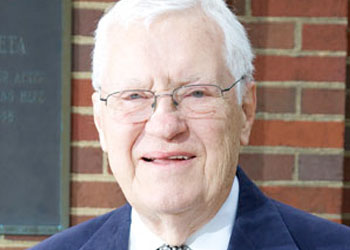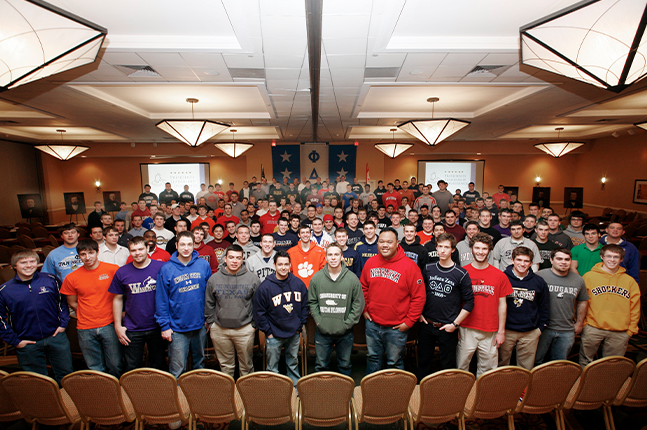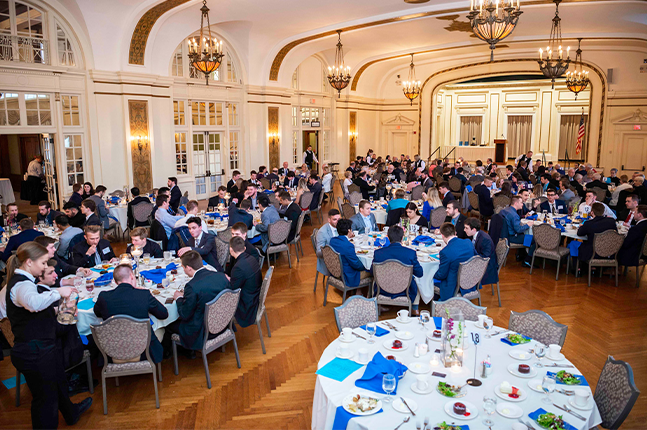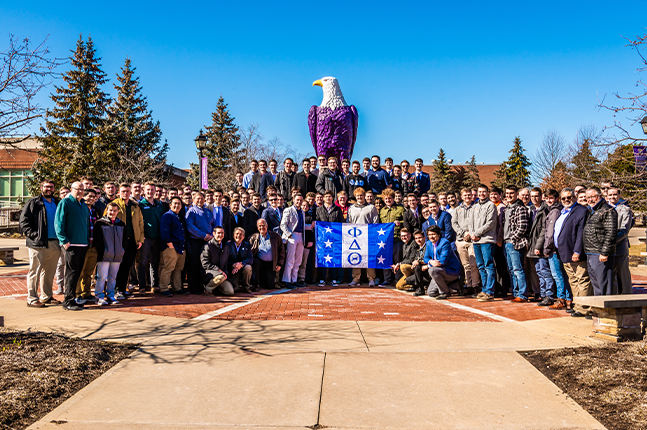A Short History of the Phi Delta Theta Foundation
In June, 1951, Robert J. Miller, New Mexico, ’50, joined the Phi Delta Theta General Headquarters staff at the invitation of Executive Secretary Paul C. Beam, Indiana-Illinois, ’25. Time in the office during the summer hours was spent, for the most part, processing chapter reports and cleaning up left over business from the prior school year, plus preparing the staff for the ensuing academic year.
During the summer of 1954, Miller found time to page through some of the magazines from other fraternities which were on display in the exchange rack. It was common practice for fraternities (sororities) to exchange their publications with other Greek letter organizations. An article in the Caduceus of Kappa Sigma Fraternity caught his eye, and he wasted no time marching into Brother Beam’s office with the question “Why doesn’t Phi Delta Theta have a scholarship foundation?” An article in the Kappa Sigma journal reported on the scholarships awarded that year to members all over the country, and it appeared that at least one brother in practically every chapter received an honorarium even if it was only $50.
This led to a discussion of how to best approach the establishment of a fund, devoted to granting scholarship rewards, within Phi Delta Theta. A provision would need to be included in the Code (Constitution and General Statutes); it would require the approval of a General Convention and legal help would be needed to be certain that the fund measured up to federal regulations. It was too late to prepare an addition to the Code at this late date with the 1954 convention only a couple months away. Beam was inundated with routine work that required his personal attention so he turned the project over to Miller.
Paul Beam passed away very unexpectedly on July 5, 1955 and any thought of legislation for a scholarship fund was put on hold. Following an executive search, Miller was eventually named Beam’s successor.
With the 1956 convention out of the way, plans developed rapidly for the new Foundation. There was reluctance on the part of some members to authorize a new money raising fund because of legislation adopted in the early 1930s which provided for alumni dues in the amount of $2.00 per year “to be deposited to the General Fraternity Fund and be dispersed under the direction of the General Council…” Obviously this income was used to administer the needs of the Fraternity.
The provision for volunteer contributions not withstanding, the 1958 convention in Asheville, North Carolina, gave unanimous approval for additions to The Code creating the Phi Delta Theta Educational Foundation.
The Foundation was incorporated in the state of Ohio on August 16, 1960, at which time six trustees were appointed and the board’s first meeting was held on September 1 of the same year. In 1962, two scholarships of $500 each were awarded.
Now that the Foundation had become a reality, the work of the new trustees had just begun. For starters, the General Council would not permit the solicitation of donations from any member who, at any time, had made a gift to the Fraternity under the alumni dues program. That meant that all soliciting had to be made in virgin territory, although brothers who had paid their “alumni dues” and wished to also give financial support to the Foundation were permitted to do so.
In due time the suggested gift of $2.00 was eliminated and later the General Council removed the restriction of soliciting from “dues paying members” with the provision that $25 of each gift would be credited to the General Fraternity account and the balance would be deposited in the Foundation account unless the donor requested an alternate distribution. This was a boon to the Fraternity because the average gift had been below $25, and it was an asset to the Foundation because it opened the prospective donor base.
By 1982, the Foundation was awarding as many as 28 scholarships of $1,200 each plus a Priest Award to an outstanding undergraduate of $2,000. The board underwent a reorganization in 1984. The president of the board became the Chairman and the title of President was given to Miller who made arrangements with his Fraternity governing board to devote 25% of his time to the Foundation. Within two years the trustees began talking about underwriting Fraternity expenses of an educational nature.
During the first thirty years of the Foundation’s existence, income was used exclusively for scholarship grants to undergraduates. Eventually, the Foundation was enabled to grant money to the Fraternity for programs of an educational nature and, still later, cash awards were made available for graduate work.
From two $500 scholarships in 1962 the capability of the Foundation Trustees grew to $183,000 in Scholarships and Fellowships plus a grant of $200,000 to the Fraternity to help underwrite the education portion of the Emerging Leaders Institute, the Chapter Consultant Program, and similar endeavors for a grand total of $383,000 in 2009.
Perhaps we should say “thank you” to Kappa Sigma for the initial inspiration.





